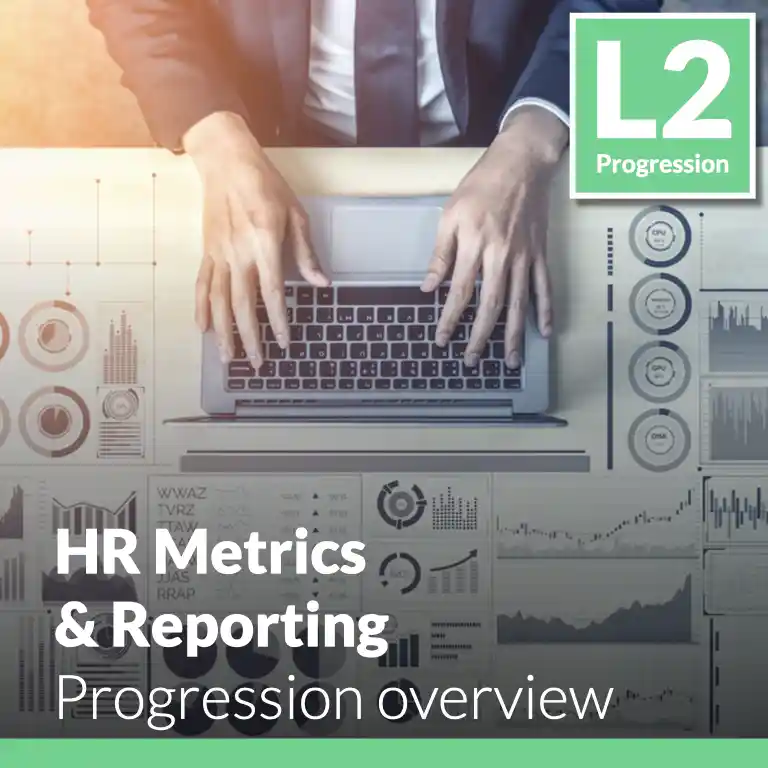Enjoy instant access to a scalable system of proven practices and execution-ready tools. Built to launch strategic HR programs 5X faster!
✓ Enjoy platform access
✓ Create your HR roadmap
✓ View open content in library
✓ Access dozens of practices:
⤷ The HR Strategy program
⤷ Explainers and deep dives
⤷ Supplemental guides
⤷ Insight articles
⤷ Weekly best practices
⤷ And more!
100% Free. No credit card required.
This guide is part of a progression set comprised of Core, Advanced, and Emerging HR Metrics & Reporting practices.
Advanced Metrics and Reporting broaden the spectrum of data used to provide more robust and refined insights that drive enhanced decision-making by HR and functional leaders while addressing the unique needs of different audiences. At this level, data from multiple HR and business systems come into use and are increasingly combined to raise the level of understanding from simply what is happening to why.
Moving beyond a "one size fits all" mentality, the metrics and reporting at this level are designed to address the information and decision needs of more targeted audiences - line supervisors or managers in different functions vs. general managers/executives, for example. While many metrics will be common to all or most groups, special attention is paid to the unique decision-making needs of each segment.
How the data is presented is also a key element of this level—moving from text, tables, and lists of averages, for example, towards graphs, charts, and other visually presented reports that make for easier and faster interpretation of the data. The presentation becomes less static and more impactful through the ability to quickly scan and identify trends over time that can identify areas for intervention and others for celebration.
Advanced Metrics and Reporting often include benchmarking—comparing the measured performance to an existing expectation, business requirement, or external standard. It provides context for internal results with meaningful comparative data that gives managers a sense of “how well are we doing?” relative to competitors or the most admired industry leaders. Such comparisons enable goal-setting and improvement targets for critical business and talent outcomes such as employee retention, revenue per employee, etc.
At this level, metrics and reporting become a user-centric activity, with their information needs and preferences considered as reports are generated. This customization for different groups or segments of management is a testament to their importance, allowing for a simplification of reporting by keeping useful data or analyses and eliminating those that do not support their operational requirements. Managers and Leaders can quickly scan and review the data and trends that matter most to them, with a degree of sophistication well within reach of many HR or Reporting teams. The data is presented to individuals who can adjust or adapt to changing trends and make the necessary improvements to their most critical operational talent concerns.
The introduction of an increased number of data sources provides the ability to integrate those into more valuable and impactful insights, such as when employee engagement data is integrated with turnover data to show how the two are related (or “co-vary”) and may influence each other. The benefits of bringing non-HR data into the mix enable a more business-focused view of the cost-effectiveness of various HR programs and processes. Enhanced presentation methods bring tremendous value to end-users, as the likelihood of their review and use of these increases with an improved “ease of use” and interpretation. That value is further enhanced by introducing external benchmarks that provide “how good is” context to the data provided, particularly when the comparison groups are relevant markers for managers, such as competitors or leading companies.
Much like basic financial, accounting, and sales reports, such reporting is designed to support managers' and leaders' decision-making with facts rather than "gut feelings" (a tendency seen when managers are making people-related (vs. financial or operational) decisions). This capability strengthens managers' ability to drive results more effectively and efficiently.
The adoption of these practices brings a significant improvement to the user experience, with data and analyses that are more relevant, easily reviewed, understood, and acted upon. This not only improves the perception of HR but also enhances the value of HR programs, making the audience feel the positive impact of these practices. The data and analyses that are produced are much more robust, as they bring multiple perspectives and nuances through the integration of multiple sources of HR, financial and business data together. Such insights are more likely to demonstrate the impact and value of various policies, programs, and workflow/process designs by using multiple sources of data. Substantially improved and more efficient reporting is produced using feedback, recommendations, and requests from end-users (in HR and line management) who can evaluate the utility of various aspects of the reports. Valuable indications of internal performance can be generated through the blending of benchmarked data into reports for comparisons to recognized and leading industry segments and competitors. With those, decisions can be made to make improvements or enhancements to existing and related processes, practices and programs.
Critical audiences typically include management from different levels and functions who will provide guidance on tailoring metrics and reporting.
As manager requests become more sophisticated, the appetite for more complex data will rise, requiring integrating data from numerous HR processes and systems.
How the data is presented is a key consideration to ensure it is easy to understand, dependable and credible, timely, and adaptable.
Comparing data from one company to that of similar companies through adequate benchmarking that generates context for better decision-making.

Enjoy instant access to a scalable system of proven practices and execution-ready tools. Built to launch strategic HR programs 5X faster!